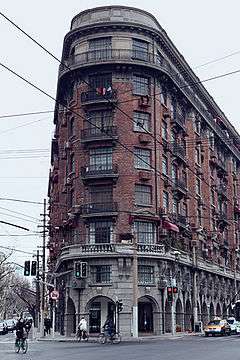Wukang Mansion
| Wukang Mansion | |
|---|---|
| 武康大楼 | |
 Wukang Mansion with Wukang Road to the left and Middle Huaihai Road to the right. | |
| Former names | Normandie Apartments |
| General information | |
| Type | Apartment |
| Architectural style | French Renaissance |
| Location | Xuhui District, Shanghai |
| Address | 1836–1858 Middle Huaihai Road |
| Country | China |
| Coordinates | 31°12′16″N 121°26′18″E / 31.2045°N 121.4383°E |
| Inaugurated | 1924 |
| Height | 30 m (98 ft) |
| Technical details | |
| Floor count | 8 |
| Floor area | 9,275 m2 (99,840 sq ft) |
| Design and construction | |
| Architect | László Hudec |
The Wukang Mansion or Wukang Building (Chinese: 武康大楼), formerly known as the Normandie Apartments or International Savings Society Apartments, is a protected historic apartment building in the former French Concession area of Shanghai. It was designed by the Hungarian-Slovak architect László Hudec and completed in 1924. The building has been the residence of many celebrities.
Location
The building is located at the southern end of Wukang Road (formerly Route Ferguson), on the corner with Middle Huaihai Road (formerly Avenue Joffre), in Shanghai's Xuhui District. It is in the western part of the former French Concession area of the city.[1] The address of the building is 1836–1858 Middle Huaihai Road.[2]
Architecture
Completed in 1924, the eight-storey building was designed by the renowned Hungarian-Slovak architect László Hudec (1893–1958), who designed many landmarks in Shanghai. It is in the French Renaissance style and is the oldest veranda-style apartment building in Shanghai.[3] Built to commemorate the Normandie, a World War I-era battleship, the building looks like a ship from one direction.[3] The unusual wedge-shape of the building is reminiscent of the Flatiron Building in New York City.[4]
The concrete building is 30 metres (98 ft) tall, occupies a land area of 1,580 square metres (17,000 sq ft), and has a floor area of 9,275 square metres (99,840 sq ft). There were originally 63 apartments, 30 servants' quarters, and three elevators.[2]
History

Originally built for Western employees of companies based in the foreign concessions, the building was bought by Kung Ling-wei, daughter of the wealthy banker H. H. Kung, in 1942.[6] Kung moved into the building, which also became popular with many celebrities of Shanghai, centre of China's film industry during the Republic of China era. Residents included famous actors and actresses Wu Yin, Wang Renmei, Qin Yi, Zhao Dan, Sun Daolin, Wang Wenjuan, Shangguan Yunzhu, and actor/director Zheng Junli.[6] Sun Daolin lived in the building for 30 years with his wife Wang Wenjuan, until his death in 2007.[2] Soong Ching-ling, the widow of President Sun Yat-sen, lived opposite the building across Huaihai Road. Her home is now open to the public as the Soong Ching-ling Memorial Residence.[2]
The former Normandie Apartments was renamed in 1953 to Wukang Mansion after the street it is on.[2] During the Cultural Revolution (1966–76), the Red Guards renamed the building Anti-Revisionist Tower,[5][6] but local residents referred to it as "The Diving Board" because of the dozens of suicides by intellectuals and others who were persecuted as "state enemies".[5] One of the most famous suicides was by the Chinese film star Shangguan Yunzhu, who jumped out of her seventh-floor window in November 1968 after being badly beaten.[5][6] The building has a local reputation for being haunted by the ghosts of people who committed suicide there.[5]
Wukang Mansion is one of Shanghai's historic buildings under municipal protection.[2] In 2008 it was restored by the government of Xuhui District.[3]
See also
References
- ↑ Pitts, Christopher (April 2013). "Concession-Era Architecture". Pocket Shanghai (3rd ed.). Lonely Planet. pp. 72–73. ISBN 978-1-74179-963-7.
- 1 2 3 4 5 6 法国式浪漫优雅的诺曼底公寓大楼 (武康大楼) (in Chinese). Shanghai Chronicles. Retrieved 5 October 2013.
- 1 2 3 "Restoring a slice of Shanghai". China Daily. Retrieved 5 October 2013.
- ↑ Bracken, Gregory Byrne (2011). "Normandie Apartments". A Walking Tour Shanghai: Sketches of the city’s architectural treasures. Marshall Cavendish International. pp. 60–61. ISBN 978-9812618658.
- 1 2 3 4 5 Knyazeva, Katya (21 October 2009). "Haunted Shanghai: A ghostly apartment building". CNN. Retrieved 5 October 2013.
- 1 2 3 4 武康大楼 停泊在上海的诺曼底战舰 (in Chinese). Xinmin News. Retrieved 5 October 2013.
Coordinates: 31°12′16″N 121°26′18″E / 31.2045°N 121.4383°E